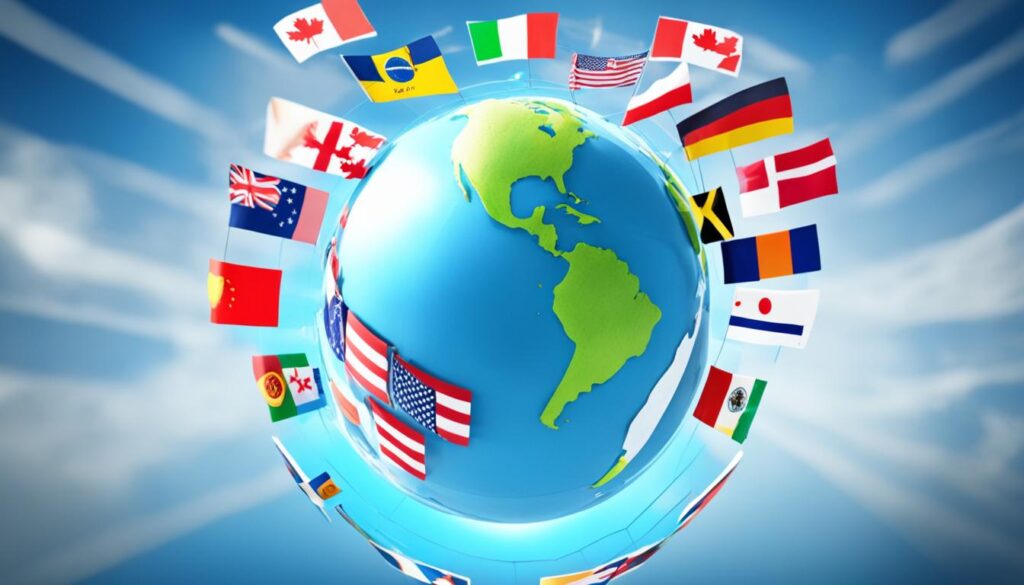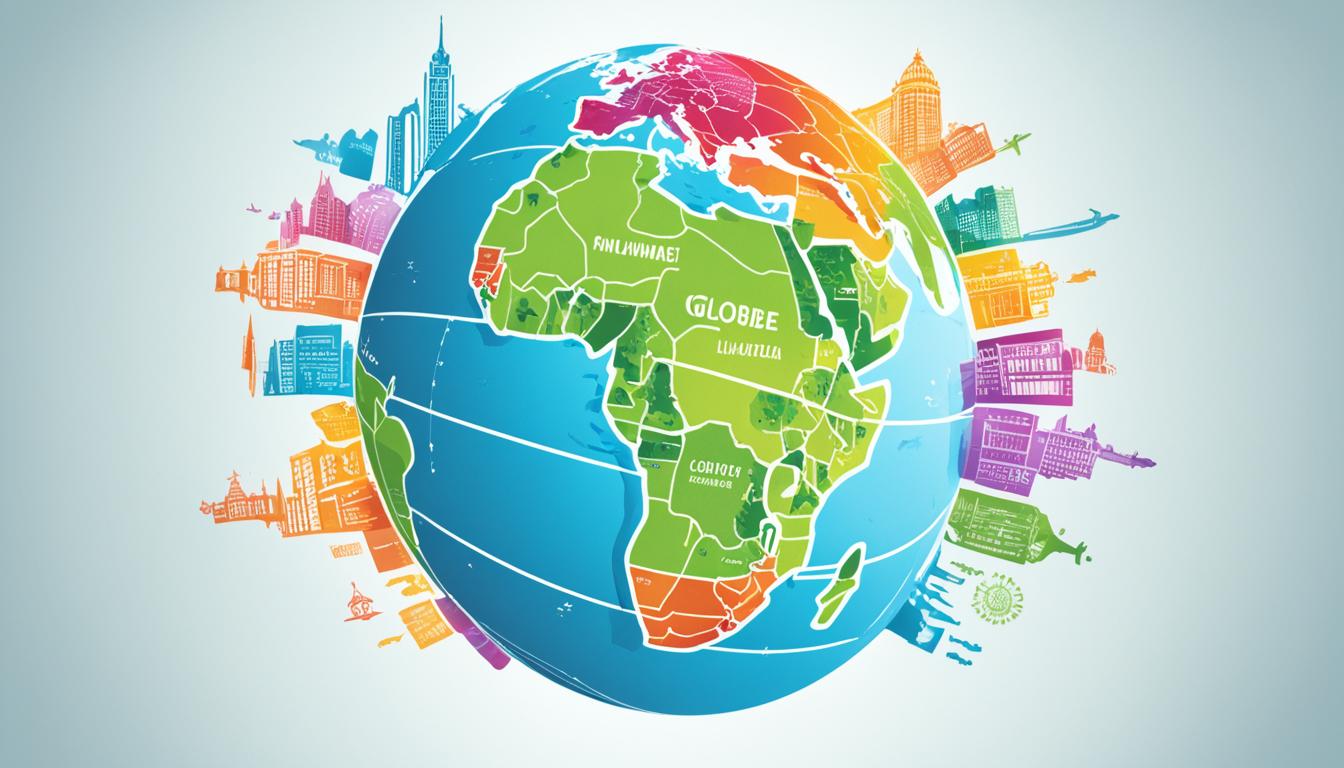How to Localize Animated Explainer Videos for Global Markets
Video content marketing is trending, and reaching foreign markets is vital. Localization is your best bet for this. Videos are powerful; they’re easy to understand, grab attention fast, and boost engagement. Since about 80% of people worldwide don’t speak English well, localizing your video gets it to more people.
To localize, you need to figure out who you’re targeting. Then plan your content and pick how to localize it. You might choose subtitles or a voice-over.
Key Takeaways:
- Video localization is key to tap into global markets and connect with diverse audiences.
- It means tweaking your animated videos to fit the language, culture, and likes of different markets.
- You can localize with subtitles, voice-overs, or dubbing.
- This approach helps businesses reach more people and ensures their message hits home in various languages and cultures.
- For B2B tech companies, video localization opens doors to the world, helping them reach more people and grow in the international market.
Defining the Local Audience in B2B Tech
To localize animated explainer videos for the B2B tech industry, know your local audience. Define your target market around tech hubs and innovation clusters. Use segmentation, proximity-based marketing, and local tech community engagement to tailor your marketing strategies. B2B tech marketers must also keep up with the competition and evolving tech trends in their targeted market.
In the B2B tech field, localizing helps you reach and engage your local audience. Adapt your animated explainer videos to the local language, culture, and preferences. This builds valuable connections and trust with potential customers. Knowing the local tech scene ensures your videos convey your message effectively and grab your audience’s attention.
Defining the Target Market
Localizing animated explainer videos means identifying your target market in tech hubs and innovation clusters. Tailor your marketing to these locations for a better reach. Understanding the demographics and preferences of your target market helps create content that resonates.
Segmenting the Tech Industry
The B2B tech industry is broad, covering many sectors and niches. Segment the industry by company size, verticals, and technology needs. This helps you create targeted video content that addresses each segment’s unique challenges with relevant solutions.
Leveraging Proximity-Based Marketing
Proximity-based marketing focuses on customers’ physical locations. In the B2B tech industry, personal connections matter. Use proximity-based marketing to build relationships. Attend local events, conferences, and tech community gatherings to interact face-to-face and earn trust from potential clients.
Engaging with Local Tech Communities
Engaging with local tech communities is key to establishing your brand. Participate in online forums, write for industry blogs, and work with local influencers. This builds a strong network and positions your brand as a trusted authority. Meaningful engagement attracts your target audience and highlights your leadership position.
The Boundless World of Global Reach
For B2B tech companies, going global with animated explainer videos promises huge growth. Markets are becoming global. So, reaching worldwide audiences is key for a strong worldwide presence. Yet, global marketing is tricky. It involves understanding cultural and language differences. B2B marketers must adapt to local markets, follow rules, and make global partnerships.
To succeed globally, B2B marketers should leverage digital tools. Tools like virtual platforms help with communication across borders. They also allow teamwork among international teams. Global data solutions are essential too. They analyze trends and behavior worldwide. This leads to smarter decisions.
To create a global marketing strategy, deep research is needed. The aim is to tailor messages for every area and group. Marketers must consider cultural differences and local tastes. By making content that connects with many audiences, businesses become trusted leaders globally.
Benefits of a Global Marketing Strategy
A global marketing strategy boosts your brand’s reputation in many markets. It helps reach new customers and grow your audience. This leads to more sales and profits. Such strategies also keep companies innovative. They use global trends to stay competitive.
“Expanding your animated explainer videos to a global market allows you to connect with diverse audiences, build brand awareness, and establish a strong international presence.”
Ignoring the global market means missing out on growth chances. As technology brings people closer, B2B marketers must embrace global opportunities. By doing so, they will succeed in today’s competitive market.
To show the power of global reach in B2B tech marketing, consider this:
| Benefits | Global Reach | Local Reach |
|---|---|---|
| Increased brand visibility | ✓ | ✗ |
| Bigger customer base | ✓ | ✗ |
| Enhanced market insights | ✓ | ✓ |
| Innovative ideas and collaborations | ✓ | ✓ |
| Competitive advantage | ✓ | ✗ |
As shown in the table, global reach has clear benefits over just local. By taking your B2B tech marketing global, you reach more people, learn more about markets, spark innovation, and edge out competitors.

Explainer Videos: The Global Communicators
Animated explainer videos are strong tools that go beyond language limits. They make tough ideas simple, perfect for all viewers. These videos grab attention and get your message across, no matter the language.
Using methods like re-voicing, dubbing, or subtitles, you can tailor explainer videos for various cultures. This means your message hits home, no matter where your audience is. It lets you share your ideas globally.
Explainer videos are great for launching a product, showing how something works, or promoting your brand. They deliver your information consistently across languages and cultures. This creates a seamless brand experience worldwide.
Simplifying Complex Concepts for Global Outreach
Explainer videos are great at making hard topics easy to get with visuals and clear scripts. They break down detailed info into small, easy-to-understand bits. This way, people everywhere can grasp complex subjects.
These videos are also flexible. You can adjust them to fit different cultural backgrounds without losing your main point. Adding subtitles or changing the voice-over lets you reach specific audiences. This makes sure your content is clear and meaningful.
Videos are in demand across various platforms. So, it’s key to connect with international viewers to grow your reach. Localizing content helps you enter new markets and find more business chances globally.
Engaging a Diverse Global Audience
Animated explainer videos can speak to people everywhere, crossing cultural and language barriers. This broadens your reach to customers, partners, and stakeholders globally.
Localizing your videos lets you match them to different audience’s tastes and cultural specifics. The right voice-over or subtitles can make your videos more engaging. This ensures your message is clear and effective.
For instance, localized subtitles can open up your content to more viewers. Or, a professional voice-over can make your message resonate in a particular market’s language.
Targeting a worldwide audience not only boosts your brand but also shows you value diversity and inclusion.
To truly engage global viewers, investing in video content localization is key. By adapting explainer videos for various languages and cultures, you connect with more people. This helps share your message widely and build global relationships.
The Concept of Video Localization
Video localization makes your video speak to viewers from other cultures. It’s not just about translating words. It also changes elements in the video for cultural fit. This includes graphics, music, and voiceovers to connect deeply with the audience.
Why do it? Localization prevents misunderstandings that come from cultural differences. It shapes your video for the audience’s tastes and expectations. By showing you understand their culture, you build trust and share your message clearly.
Content Adaptation: In video localization, changing content is key. This means tweaking scenes or characters to match the audience’s culture. It helps your video appeal more personally, boosting engagement and your message’s impact.
Relevance to Foreign Target Audience: The goal is to make your video feel made for the audience. Adding local references and terms makes the video more captivating. This customization improves understanding, keeps viewers engaged, and helps them remember your message.
Source Material as the Foundation: Your video’s original material is the starting point. It holds all the visual and audio elements. Localization experts use this to adjust each part for the audience’s culture. This ensures clear communication and avoids confusion.
Why Video Localization Matters
“Localization enhances the emotional connection between your video content and the foreign target audience, enabling you to effectively promote your brand, products, or services to a global market.
Video localization is vital for reaching international markets. It adapts your content to the audience’s language and culture. This way, it builds connections that can boost your brand and increase sales.
In our globalized world, localization is crucial for businesses entering new markets. With video being so powerful, making it culturally relevant can greatly aid your marketing.
| Benefits of Video Localization | Examples |
|---|---|
| Expanded Global Audience Reach | Increased market share, international brand recognition |
| Cultural Relevance | Avoidance of cultural misunderstandings, improved engagement |
| Enhanced Communication | Captivating storytelling, increased message retention |
| Improved Business Opportunities | Establishment of international partnerships, growth potential in new markets |
Who Needs Video Content Localization?
Video content localization is key for companies wanting to go global with their videos. It’s about making sure your videos fit different cultures and languages. This way, you can reach more people around the world. Localization makes your video content relatable everywhere, boosting your global reach.
Here are some examples of businesses that gain a lot from video content localization:
- Advertising and Promotional Videos: Localization makes sure your brand’s message hits home in various countries. It grabs the attention of people worldwide.
- E-Learning and Explainer Videos: For teaching a global crowd, localization adjusts your content for local cultures and languages. This helps people understand and connect better.
- Brand/Product/Service Videos: Localization shares your brand’s story or explains your services in a way that different cultures get. It builds brand awareness and trust globally.
- Cartoons and Movies: In the world of entertainment, localization lets different cultures enjoy the stories, characters, and humor.
Localizing your video content opens doors to international markets and growth. It overcomes language barriers and connects with people in many places. Doing so can boost your success worldwide.
Source as the Most Important Element for Localization
The source material is the key to successful video localization. It includes graphics, soundtrack, animatics, voiceover, and music. To localize your video, these parts must be adjusted for your audience’s culture and preferences.
Localization makes your video clear and relatable to a specific group. It helps overcome cultural and language barriers. This way, your message connects with people worldwide. The source material helps customize your content for different markets, making your video more powerful.
Localization means adjusting your video to fit linguistic and cultural details. It’s more than translating; it includes changing graphics, sounds, and even character actions to match your audience’s culture. Doing this makes your video informative, enjoyable, and more relatable.
Localization demands skill and care. It’s about understanding culture, language, and market needs. By focusing on the source material, your animated video reaches your viewers’ hearts and minds, crossing language and cultural divides.
Possible Problems You May Encounter When Localizing Video
Video localization can be tricky, with both marketing and technical hurdles. When localizing explainer videos, knowing potential issues is key. This knowledge helps ensure a smooth process.
1. Ensuring Consistency with Multiple Translators
Using many translators can make it hard to keep the video’s message unified. It’s vital to set clear rules and communicate well. This way, the final video will send a consistent message.
2. Avoiding Blind Translation
Blind translation means translating text without seeing the video. This can cause mismatches between words and images. Giving translators access to the video helps avoid this and ensures a better fit between speech and scene.
3. Addressing Lip-Sync Difficulties
Lip-syncing is tough when translating spoken words to match mouth movements. It’s crucial for dubbing in new languages. Translators need to carefully match dialogue timing to the characters’ mouths for a natural look.
4. Considering Simplified Localization Options
There might be times when you need to simplify your localization due to budget. Options include re-voicing, dubbing, or adding subtitles. Choosing the right method depends on your budget and project needs.
Knowing these challenges and planning for them can help make your video localization successful. This way, your explainer videos will be engaging and effective worldwide.
Simplified Video Localization Options
If budget is tight, you don’t have to worry. You can still make your videos reach a global audience. There are simple video localization options available. Here, we’ll discuss three popular methods:
Re-voicing
Re-voicing changes the video’s audio by adding a new voiceover in a different language. This way, the original video looks the same, but it sounds different. It lets you keep the video’s original style while making it understandable in another language.
Dubbing
Dubbing is another way to localize videos. It adds a new voice in another language but keeps the original sound effects. This means people can watch the video in their language and still enjoy the original sounds. It’s a common choice for movies and TV shows, letting international viewers get more into what they’re watching.
Subtitles
Adding subtitles is a wallet-friendly way to adapt your videos. Subtitles show the translation on screen but keep the original audio. This is perfect for viewers who like hearing the original voices or for those who can’t hear well.
Even though these aren’t as thorough as a full localization, they’re still great for breaking language barriers. They help your videos reach more people around the world.

Comparative Overview of Video Localization Options
| Localization Method | Pros | Cons |
|---|---|---|
| Re-voicing | – Retains original visuals – Preserves voice acting nuances – Provides localized audio |
– Costly for longer videos – Requires accurate translation |
| Dubbing | – Offers an immersive experience – Allows for seamless integration with original audio – Suitable for longer videos |
– Requires synchronization of lip movements – Can be time-consuming to produce |
| Subtitles | – Cost-effective option – Preserves original audio – Allows for multilingual distribution |
– Requires viewers to read while watching – May obstruct visuals in certain formats |
Conclusion
Video localization helps you reach people all over the world. By making your animated explainer videos fit the language and culture of different places, you can grow globally. You can use subtitles, voice-overs, or dubbing to do this.
B2B tech companies can go international with video localization. It lets you share your message in a way that feels right to local people. This builds trust and a strong global presence.
By taking your videos worldwide, you can attract more customers and get your brand known. Since 80% of people worldwide don’t speak English well, localizing your videos is key. This way, your message gets across clearly, helping your business grow big globally.







